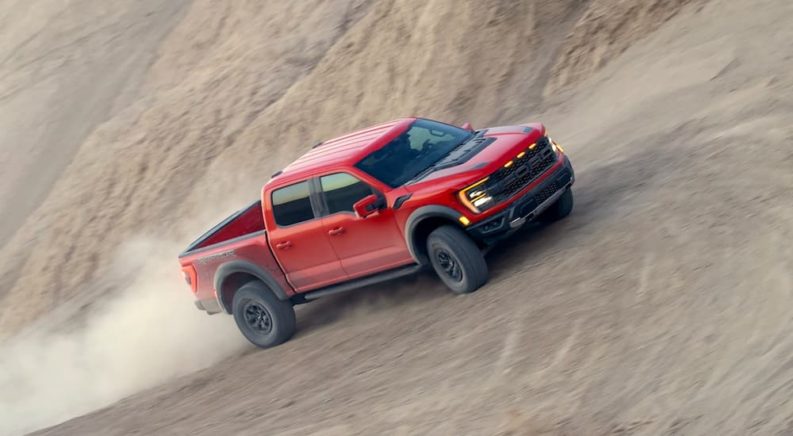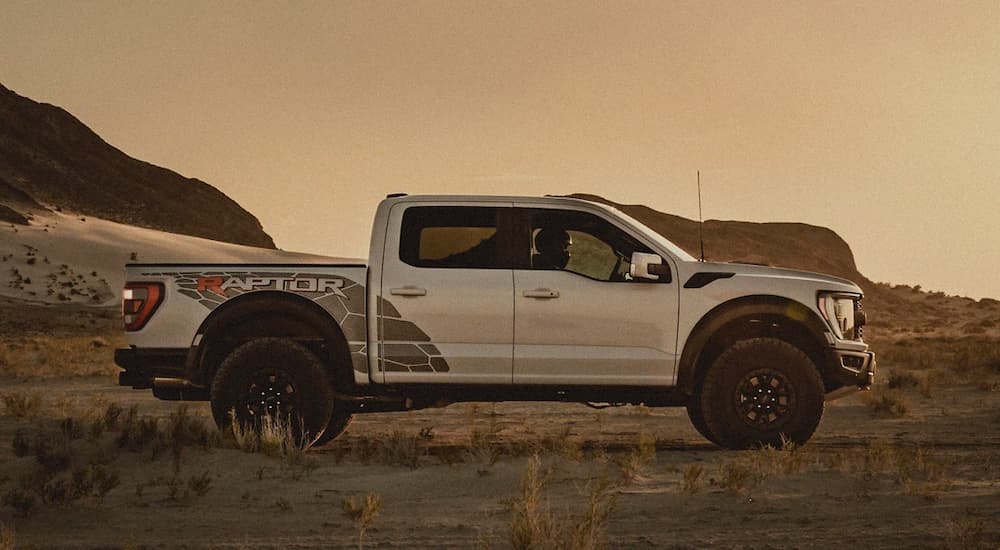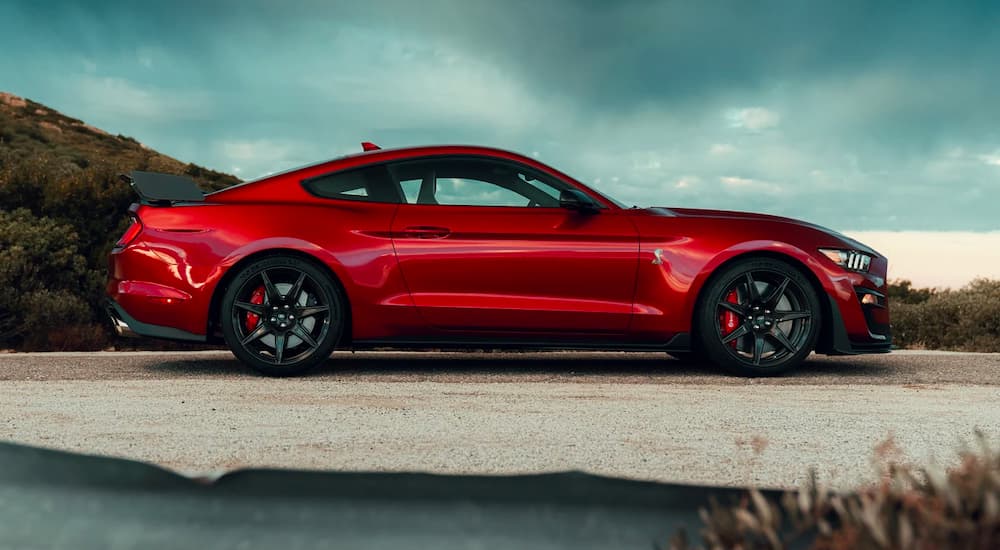In the wild, speed is everything. The ability to chase down prey or run from a predator can be the difference between life and death, giving the fleet of foot a marked advantage in the neverending contest that is natural selection. Survival of the fittest has been the governing law of nature since prehistoric times when apex predators like the velociraptor pursued their next meal at speeds of up to 25 mph. That swift raptor lineage lives on today in a more feathery form, with the birds of prey like the peregrine falcon that stalk the skies and divebomb their prey at speeds of up to 240 mph.
Falling between these two legendary predators is a new addition to the raptor family: the Ford F-150 Raptor pickup. With a manufacturer-capped top speed of 120 mph, Ford’s high-performance pickup is an aptly named speedster that carries on the lightning-fast legacy established by some of nature’s greatest hunters. The pickup’s prey? Off-road glory, with a massive engine and all the heavy-duty components necessary to be crowned king of the jungle, or more likely, desert. As the prototypical supertruck marches into its third generation, it’s as popular as ever, making brand-new models difficult to come by. Luckily it’s not as tough to find a used Raptor for sale, with the pickup providing a readymade platform for those looking to explore everything the off-road scene has to offer. Let’s get into some of the stats that set this impressive specimen when it comes to the most relevant metric for trophy truck supremacy: speed.
Speed Thrills
The Raptor represents a new breed of supertrucks that are challenging the notion of just what a pickup can be. While the F-150’s massive silhouette might not be out of place in the desert-racing environs of Moab, Utah, or the Baja peninsula, street-legal versions have historically been more difficult to come by. The Raptor made waves upon its initial release back in 2010, with Ford perfecting the pickup in subsequent generations, with new models hitting the market in 2017 and 2021.
Every generation of the Raptor included a host of rugged off-road equipment, but it’s the pure speed that truly set these models apart. The 2022 F-150 Raptor, for example, comes standard with a twin-turbo 3.5-liter V6 paired with a ten-speed automatic that’s good for 450 horsepower and 510 lb-ft of torque. The only thing preventing the Raptor from breaking the sound barrier is the factory-installed limiter, which caps the pickup’s power at 120 mph in order to limit stress on the driveshaft and tires. While safety concerns stop us from advising a limiter bypass, some third-party testing has shown that without it, the Raptor can reach speeds in excess of 135 mph.
Despite the Raptor’s 5,000-plus-pound bulk, the truck easily has enough power to tear from zero to 60 mph in just 5.3 seconds: a figure almost unmatched in the full-size truck segment with the exception of some new all-electric models. The third-generation Raptor rounds out its resume with an impressive slate of times, accelerating from zero to 100 mph in 14.7 seconds with a quarter mile time of 13.9 seconds at 98 mph. That should be more than enough speed for any driver outside of the desert racing circuit, but for those who revel in the excess that only a true supertruck can deliver, Ford has an even more powerful option coming for 2023.
Prehistoric Rivalry
The Ford Raptor R takes everything there is to love about the base Raptor and elevates it to another level, replacing the V6 engine with a powerful V8 that’ll be familiar to any fans of the brand’s storied Mustang Shelby GT500. Ford has lifted the supercharged 5.2-liter Predator engine from the high-performance version of its trailblazing pony car, giving the Raptor R some 700 horsepower and 640 lb-ft of torque to play with. That’s slightly less than the 760 horsepower it can produce when under the hood of the Mustang Shelby GT500, but the Raptor has a 15 lb-ft edge when it comes to torque. This is a logical trade-off given the importance of torque in off-road applications and something we can definitely learn to live with. Again, the top speed has been artificially limited, but the Raptor R does shave nearly a second off the base model’s zero-to-60 time, clocking in at an estimated 4.4 seconds.
That 4.4-second figure is particularly important given the presence of another contender for the apex supertruck crown in the Ram TRX. The two trucks are conceptual twins, sharing the same off-road focus, massive engine, and prehistoric branding, though they differ in some important ways. The Raptor R is significantly lighter than Ram’s offering, weighing 6,100 lbs to the TRX’s 6,800 lbs. Those 700 lbs make all the difference when it comes to acceleration, giving the Raptor a superior weight-to-power ratio of 8.6 lbs per horsepower compared to the Ram’s 9.6 lbs.
Despite having a smaller displacement and torque rating than the 6.2L HEMI V8 found in the TRX, the lighter Raptor shaves almost 0.2 seconds off the Ram’s zero-to-sixty time which, while not the end-all-be-all for most drivers, is a nice feather in its cap. It’s not just the lower weight that allows the Raptor to best the TRX, but also the pickup’s engine design. The 5.2-liter engine might only have 83 percent of the Ram’s displacement, but it still manages to produce 99.7 percent of the power and 98.5 percent of the torque. These figures speak to Ford’s superior engineering approach, which, by using a dual-overhead-cam valvetrain spinning 14.8 percent faster than the Ram’s pushrod design and a larger blower to increase boost pressure, manages to beat the TRX in the battle of brains versus brawn.
The Raptor also beats the TRX in another vital category in any pickup head-to-head: towing and payload capacity. The lighter Raptor has a decided advantage when it comes to towing, outperforming the Ram pickup with an 8,200-lb towing capacity to the TRX’s 8,100 lbs. While this gives the Raptor an edge when it comes to on-road performance, towing is only half the battle, with payload rating often representing more of a dealbreaker for those who like to load up their pickups for a weekend full of off-road adventure. The Raptor comes out on top here, too, with a 1,410-lb payload rating that outshines the TRX by 60 pounds.
The Leader of the Supertruck Pack
When it comes to pure speed, few pickups can match the performance of the Ford Raptor. With some 450 to 700 horsepower to play with, the Raptor provides the type of acceleration and top speed that might have drivers quickly forgetting that they’re behind the wheel of a pickup at all. Whether there’s a V6 or a powerful new Mustang Shelby GT500-inspired V8 under the hood, both engines pair well with the pickup’s long list of off-road components. This combination gives drivers everything they need to explore the road less traveled by providing them with a street-legal version of the high-performance trophy trucks that can be seen cutting through some of the world’s most famous off-road courses. Importantly, the Raptor is just as capable as an everyday driver, with a comfortable ride and generous suite of high-end luxury and tech features that justify the pickup’s relatively high price tag. If you’re looking for a compelling synthesis of power, performance, and off-road capability, few pickups can keep pace with the Ford F-150 Raptor.






